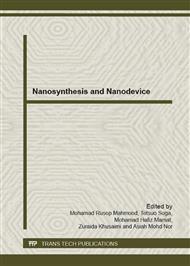[1]
F.S. -S. Chien, C. -R. Wang, Y. -L. Chan, H. -L. Lin, M. -H. Chen, R. -J. Wu, Fast-response ozone sensor with ZnO nanorods grown by chemical vapor deposition, Sensors and Actuators B: Chemical 144 (2010) 120-125.
DOI: 10.1016/j.snb.2009.10.043
Google Scholar
[2]
N. Chiodarelli, O. Richard, H. Bender, M. Heyns, S. De Gendt, G. Groeseneken, P.M. Vereecken, Correlation between number of walls and diameter in multiwall carbon nanotubes grown by chemical vapor deposition, Carbon 50 (2012) 1748-1752.
DOI: 10.1016/j.carbon.2011.12.020
Google Scholar
[3]
R. Jemai, A. Alaya, O. Meskini, M. Nouiri, R. Mghaieth, K. Khirouni, S. Alaya, Electrical properties study of double porous silicon layers: Conduction mechanisms, Materials Science and Engineering: B 137 (2007) 263-267.
DOI: 10.1016/j.mseb.2006.12.003
Google Scholar
[4]
R.L. Smith, S.D. Collins, Porous silicon formation mechanisms, Journal of Applied Physics, 71 (1992) R1-R22.
DOI: 10.1063/1.350839
Google Scholar
[5]
C.K. Sheng, W. Mahmood Mat Yunus, W.M.Z.W. Yunus, Z. Abidin Talib, A. Kassim, Characterization of thermal, optical and carrier transport properties of porous silicon using the photoacoustic technique, Physica B: Condensed Matter 403 (2008).
DOI: 10.1016/j.physb.2008.01.029
Google Scholar
[6]
M. Archer, M. Christophersen, P.M. Fauchet, Electrical porous silicon chemical sensor for detection of organic solvents, Sensors and Actuators B: Chemical 106 (2005) 347-357.
DOI: 10.1016/j.snb.2004.08.016
Google Scholar
[7]
P.M. Fauchet, The integration of nanoscale porous silicon light emitters: materials science, properties, and integration with electronic circuitry, Journal of Luminescence 80 (1998) 53-64.
DOI: 10.1016/s0022-2313(98)00070-2
Google Scholar
[8]
S.A. Bakar, S. Muhamad, P.S.M. Saad, S.A.M. Zobir, R.M. Nor, Y.M. Siran, S.A.M. Rejab, A.J. Asis, S. Tahiruddin, S. Abdullah, M.R. Mahmood, The Effect of Precursor Vaporization Temperature on the Growth of Vertically Aligned Carbon Nanotubes using Palm Oil, Defect and Diffusion Forum 312-315 (2011).
DOI: 10.4028/www.scientific.net/ddf.312-315.906
Google Scholar
[9]
K. Watanabe, T. Okada, I. Choe, Y. Sato, Organic vapor sensitivity in a porous silicon device, Sensors and Actuators B: Chemical 33 (1996) 194-197.
DOI: 10.1016/0925-4005(96)80097-9
Google Scholar
[10]
J. Dian, A. Macek, D. Nižňanský, I. Němec, V. Vrkoslav, T. Chvojka, I. Jelı́nek, SEM and HRTEM study of porous silicon—relationship between fabrication, morphology and optical properties, Applied Surface Science 238 (2004) 169-174.
DOI: 10.1016/j.apsusc.2004.05.218
Google Scholar


